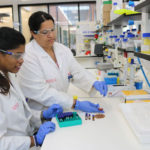First, do no harm

Australians are increasingly being diagnosed with cancers that will do them no harm if left undetected or untreated, exposing them to unnecessary surgeries and chemotherapy, according to a new study published online in the Medical Journal of Australia.
The research, led by Professor Paul Glasziou, the Director of the Institute for Evidence-Based Healthcare at Bond University, drew on data from the Australian Institute of Health and Welfare to compare how the lifetime risk of five cancers had changed between 1982 and 2012.
The study shows compared to 30 years ago, Australians are much more likely to experience a cancer diagnosis in their lifetime.
The figures suggest that in 2012 24 percent of cancers or carcinomas in men were overdiagnosed. These included 42 percent of prostate cancers, 42 percent of renal cancers, 73 percent of thyroid cancers and 58 percent of melanomas.
For women, 18 percent of cancers or carcinomas were overdiagnosed, including 22 percent of breast cancers, 58 percent of renal cancers, 73 percent of thyroid cancers and 58 percent of melanomas.
The figures are significant because of the harm that can occur from cancer treatment of patients who would never have had symptoms in their lifetime.
“Cancer treatments such as surgery, radiotherapy, endocrine and chemotherapy carry risks of physical harms,” the authors of the study reported.
“In the absence of overdiagnosis, these harms are generally considered acceptable.
“In the context of overdiagnosed cancers, however, affected individuals cannot benefit but can only be harmed by these treatments.”
The authors also refer to separate studies showing overdiagnosis could be linked to psychological problems.
“For example, men’s risk of suicide appears to increase in the year after receiving a prostate cancer diagnosis.”
The new study, which was led by Professor Glasziou in conjunction with co-authors Professor Alexandra Barratt and Associate Professor Katy Bell of University of Sydney, Associate Professor Mark Jones of Bond University, and Dr Thanya Pathirana of Griffith University, calls for urgent policy changes to address overdiagnosis.
Professor Glasziou said increasing rates of diagnosis were a result of improvements and wider use of testing and screening.
“The problem is that some screening identifies abnormal cells that look like cancer but don’t behave like cancer. However, reducing that problem is not easy, as some types of screening are important”.
Professor Glasziou said the best option to reducing melanoma deaths may not be ever–more screening “but applying daily sunscreen” and research on better treatments.
“While much of the overdiagnosis is due to screening, many overdiagnosed cancer cases are incidental findings, that is, the patient is being tested for something else when the cancer is detected,” Professor Glasziou said.
“Getting the balance right between too little and too much screening and testing will not be easy, but this is an important step.
It is the first time that the risk of overdiagnosis has been quantified across five cancers, anywhere in the world.”
Associate Professor Bell said that the findings also suggest an important role for health services such as the Australian Institute of Health and Welfare, in detecting potential overdiagnosis and alerting health policy decision makers to the problem early on.
“Patterns of increased test use, cancer incidence, or treatment rates, without corresponding rises in mortality could indicate emerging areas of overdiagnosis,” she said.
“People still need to remain vigilant when it comes to early detection of cancers, however they need to be informed and engage in shared decision making with their medical professionals about the harms of cancer screening and other associated procedures.”
Open Forum is a policy discussion website produced by Global Access Partners – Australia’s Institute for Active Policy. We welcome contributions and invite you to submit a blog to the editor and follow us on Facebook, Linkedin and Mastadon.













